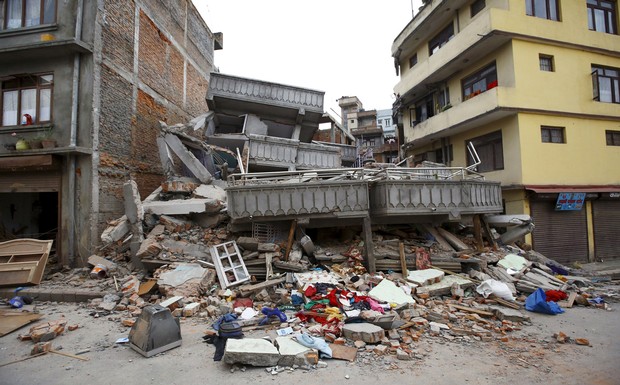
A powerful earthquake struck Nepal Saturday, killing at least 970 people across a swath of four countries as the violently shaking earth collapsed houses, leveled centuries-old temples and triggered avalanches on Mt. Everest. It was the worst tremor to hit the poor South Asian nation in over 80 years. At least 688 people were confirmed dead in Nepal, according to the police. Another 20 were killed in India, six in Tibet and two in Bangladesh. Two Chinese citizens died at the Nepal-China border. Given the scale of the destruction, the death toll is almost certain to rise, said Home Ministry official Laxmi Dhakal. It was a few minutes before noon when the quake, with a preliminary magnitude of 7.8, began to rumble across the densely populated Kathmandu Valley, rippling through the capital Kathmandu and spreading in all directions — north toward the Himalayas and Tibet, south to the Indo-Gangetic plains, east toward the Brahmaputra delta of Bangladesh and west toward the historical city of Lahore in Pakistan. A magnitude-6.6 aftershock hit about an hour later, and smaller aftershocks continued to jolt the region for hours. Residents ran out of homes and buildings in panic. Walls tumbled, large cracks opened up on streets and walls. Towers collapsed and clouds of dust began to swirl all around. Within hours, hospitals began to fill up with dozens of injured people. Many came to the main hospital in central Kathmandu. Among them was Pushpa Das, a laborer, ran from the house when the first quake struck but could not escape a collapsing wall that injured his arm. “It was very scary. The earth was moving … I am waiting for treatment but the (hospital) staff is overwhelmed,” he said, gingerly holding his right arm with his left hand. As he spoke dozens of more people showed up with injuries, mostly from falling bricks. Following the quake, Kathmandu’s international airport was shut down. While the extent of the damage and the scale of the disaster are yet to be ascertained, the quake will likely put a huge strain on the resources of this poor country best known for Everest, the highest mountain in the world, and its rich Hindu culture. The economy of Nepal, a nation of 27.8 million people, is heavily dependent on tourism, principally trekking and Himalayan mountain climbing. A senior mountaineering guide, Ang Tshering, said an avalanche swept the face of Mt. Everest after the earthquake, and government officials said at least 30 people were injured. Tshering of the Nepal Mountaineering Association said the avalanche occurred between the Khumbu Icefall, a rugged area of collapsed ice and snow, and the base camp where most climbing expeditions have their main camps. Carsten Lillelund Pedersen, a Dane who is climbing the Everest with a Belgian climber Jelle Veyt, said on his Facebook page that they were at Khumbu Icefall , a rugged area of collapsed ice and snow close to base camp at altitude 5,000 meters (16,500 feet) when the earthquake hit. He wrote on his Facebook that they have started to receive the injured, including one person with the most severe injuries who sustained many fractures. “He was blown away by the avalanche and broke both legs. For the camps closer to where the avalanche hit, our Sherpas believe that a lot of people may have been buried in their tents,” he wrote in English. “There is now a steady flow of people fleeing basecamp in hope of more security further down the mountain”- Kathmandu, Apr 25 (AP/UNB)

